Hormonal hyperplasia - Study guides, Class notes & Summaries
Looking for the best study guides, study notes and summaries about Hormonal hyperplasia? On this page you'll find 1646 study documents about Hormonal hyperplasia.
Page 3 out of 1.646 results
Sort by
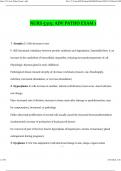
-
NURS 5315 Advanced Pathophysiology Exam 1 2024 Actual Questions with Verified Answers, 100% Guarantee Pass
- Exam (elaborations) • 96 pages • 2024
-
- $12.99
- + learn more
NURS 5315 Advanced Pathophysiology Exam 1 2024 Actual Questions with Verified Answers, 100% Guarantee Pass Atrophy: E. Cells decrease in size P. Still functional; imbalance between protein synthesis and degradation. Essentiallythere is an increase in the catabolism of intracellular organelles, reducing structuralcomponents of cell Physiologic: thymus gland in early childhood Pathological: disuse (muscle atrophy d/ decrease workload, pressure, use, bloodsupply, nutrition, hormonal stimulation, or...
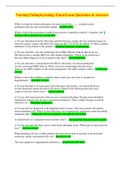
-
Nursing Pathophysiology Final Exam Questions & Answers
- Exam (elaborations) • 19 pages • 2023
-
Available in package deal
-
- $14.64
- 2x sold
- + learn more
Nursing Pathophysiology Final Exam Questions & Answers-While viewing the electrocardiogram, the nurse recalls the _____ conducts action potentials down the atrioventricular septum. - Bundle of His Which of the following patient would be most prone to metabolic acidosis? A patient with: - Diabetes whose glucoses are uncontrolled A 76-year-old patient had the following arterial blood gas sample after his stomach surgery in which his gastric content and fluid were removed: pH 7.55, PCO2 50,...

-
Pathophysiology (NR283) Study Guide Exam 1 Questions and Answers Graded A 2024
- Exam (elaborations) • 16 pages • 2024
-
- $14.49
- + learn more
Hypertrophy Increase in cell size - results in enlarged tissue mass Causes of hypertrophy Additional work by the tissue Excessive hormonal stimulation Examples of hypertrophy Enlarged heart resulting from increased demands Effect of consistent exercise on skeletal muscle, leading to an enlarged muscle mass Atrophy Decrease in cell size - results in reduced tissue mass Causes of atrophy Reduced use of the tissue Insufficient nutrition Decreased neurologic or hormonal stimulatio...
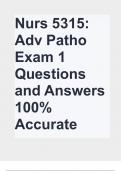
-
Nurs 5315: Adv Patho Exam 1 Questions and Answers 100% Accurate
- Exam (elaborations) • 43 pages • 2024
-
Available in package deal
-
- $14.99
- + learn more
Nurs 5315: Adv Patho Exam 1 Questions and Answers 100% AccurateNurs 5315: Adv Patho Exam 1 Questions and Answers 100% AccurateNurs 5315: Adv Patho Exam 1 Questions and Answers 100% Accurate Atrophy - ANSWER-E. Cells decrease in size P. Still functional; imbalance between protein synthesis and degradation. Essentially there is an increase in the catabolism of intracellular organelles, reducing structural components of cell Physiologic: thymus gland in early childhood Pathological: disuse (mus...
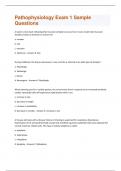
-
Pathophysiology Exam 1 Sample Questions And Answers With Verified Solutions
- Exam (elaborations) • 48 pages • 2024
- Available in package deal
-
- $7.99
- + learn more
A report comes back indicating that muscular atrophy has occurred. A nurse recalls that muscular atrophy involves a decrease in muscle cell: a. number b. size c. vacuoles d. lipofuscin - Answer-B. Size During childhood, the thymus decreases in size, and this is referred to as what type of atrophy? a. Physiologic b. Pathologic c. Disuse d. Neurogenic - Answer-A. Physiologic When planning care for a cardiac patient, the nurse knows that in response to an increased workload, cardiac myo...

-
NURS 5315: ADV PATHO EXAM 1 2024/NEWEST VERSION WITH CORRECT DETAILED SOLUTIONS /A+ ASSURED E. Cells decrease in size P. Still functional; imbalance between protein synthesis and degradation. Essentially there is an increase in the catabolism of intrace
- Exam (elaborations) • 33 pages • 2024
-
Available in package deal
-
- $14.99
- + learn more
NURS 5315: ADV PATHO EXAM 1 2024/NEWEST VERSION WITH CORRECT DETAILED SOLUTIONS /A+ ASSURED E. Cells decrease in size P. Still functional; imbalance between protein synthesis and degradation. Essentially there is an increase in the catabolism of intracellular organelles, reducing structural components of cell Physiologic: thymus gland in early childhood Pathological: disuse (muscle atrophy d/ decrease workload, pressure, use, blood supply, nutrition, hormonal stimulation, or nervous stimu...
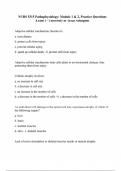
-
NURS 5315 Pathophysiology: Module 1 & 2, Practice Questions Exam 1 - University of Texas Arlington
- Exam (elaborations) • 80 pages • 2024
-
Available in package deal
-
- $13.00
- + learn more
Adaptive cellular mechanisms function to: a. treat disease b. protect cells from injury c. prevent cellular aging d. speed up cellular death - b. protect cells from injury Adaptive cellular mechanisms help cells adjust to environmental changes, thus protecting them from injury Cellular atrophy involves: a. an increase in cell size b. a decrease in cell size c. an increase in the number of cells d. a decrease in the number of cells - b. a decrease in the number of cells. An individual...
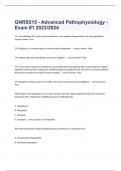
-
GNRS515 - Advanced Pathophysiology - Exam #1 2023/2024
- Exam (elaborations) • 23 pages • 2023
-
Available in package deal
-
- $16.49
- + learn more
T/F: Non-dividing cells, such as myocardial fibers, are capable of hypertrophy, but not hyperplasia. - correct answer True T/F: Dysplasia is a common type of normal cellular adaptation. - correct answer False T/F: Hypertrophy and hyperplasia rarely occur together. - correct answer False T/F: A man with a history of smoking has a bronchial biopsy showing that the normal columnar ciliated epithelial cells have been replaced by stratified squamous epithelial cells. The man is correct...
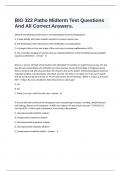
-
BIO 322 Patho Midterm Test Questions And All Correct Answers.
- Exam (elaborations) • 12 pages • 2024
-
Available in package deal
-
- $9.99
- + learn more
Which if the following would result in non-pathological hormonal hyperplasia? A. A body builder who takes anabolic steroids to increase muscle mass. B. The thickening of the endometrium after fertilization and implantation C. A change in the cell size and shape of the cervix due to human papillomavirus (HPV) D. The reversible changing of normal columnar ciliated epithelium of the bronchial lining by stratified squamous epithelium. - Answer B. Elissa is a 16 year old high school studen...
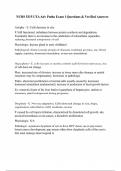
-
NURS 5315 UTA Adv Patho Exam 1 Questions & Verified Answers
- Exam (elaborations) • 67 pages • 2024
-
- $12.00
- + learn more
Atrophy - E. Cells decrease in size P. Still functional; imbalance between protein synthesis and degradation. Essentially there is an increase in the catabolism of intracellular organelles, reducing structural components of cell Physiologic: thymus gland in early childhood Pathological: disuse (muscle atrophy d/ decrease workload, pressure, use, blood supply, nutrition, hormonal stimulation, or nervous stimulation) Hyperplasia - E: cells increase in number, mitosis (cell division) must oc...

$6.50 for your textbook summary multiplied by 100 fellow students... Do the math: that's a lot of money! Don't be a thief of your own wallet and start uploading yours now. Discover all about earning on Stuvia


